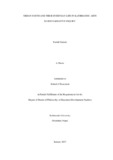
Please use this identifier to cite or link to this item:
https://hdl.handle.net/20.500.14301/524| Title: | Urban Youth and their Everyday Life in Kathmandu: Arts Based Narrative Inquiry |
| Authors: | Gautam, Suresh |
| Citation: | Gautam,S.(2017).Urban youth and their everyday life in Kathmandu: Arts based narrative inquiry. |
| Issue Date: | Jan-2017 |
| Publisher: | Kathmandu University School of Education |
| School: | SOED |
| Department: | DODE |
| Level: | Ph.D. |
| Program: | PhD in Development Education |
| Abstract: | The thesis aims to uncover the everyday life of urban youth living in Kathmandu. Initially, the research concept was conceived from my observation of and interaction with the urban youth who were my undergraduate students whose ways of being, living, learning, and thinking were typically shaped by urbanism. In this regard, I set a preliminary research question, “How do urban youth experience their being, living and learning in Kathmandu?” which guided me to conduct the fieldwork. During my engagement in the field some other research questions emerged and I was unpacking the everyday life of urban youth. In the initial stage of the fieldwork, I interacted and observed several youth from various locations in Kathmandu, where I chose six participants for deeper understanding of their ways of being, living, and learning. Then, I deepened the arena of my observation and started making meaning of the everyday life of urban youth. Employing the arts based narrative inquiry; I come up with emergent research questions “ How do I engage with urban youth in Kathmandu as a cultural insider/outsider?” leading to three main key constructs of the research, namely (i) arrival in Kathmandu, (ii) survival in Kathmandu, and (iii) revival in Kathmandu. iv These three major constructs emerged from the diachronic everyday life activities of the urban youth. First, everyday life of urban youth in Kathmandu may not only be the (re)product of alienation but the product of the transformative process. Second, youth experience urbanism as a way of life, where they interact and negotiate with time and space, which creates and recreates the identities of urban youth. Third, youth in city reset their purpose after their arrival, as a result, they struggle to get opportunities, face many adversities and ultimately, become resilient in their everyday life. Fourth, cities have a stronger sense to flourish the active consciousness of youth citizens where they learn to live and demonstrate their agency. Lastly, youth learn from their everyday life practices in the glocalized space of Kathmandu. With these constructs, I particularly served the purpose of my research in three different layers: first, unfolding the experience of the youth as arrival, second, unpacking their worldviews of survival, and third, uncovering the notion of revival in their everyday life activities in Kathmandu. Thus, throughout the research, I uncovered, critiqued and envisioned the everyday life perspectives of urban youth in Kathmandu. In doing so, I employed mandalic research space, believing the post ontological nature of reality, which mainly served my three interests to be (i) a storyteller when I like to tell stories of my participants, (ii) an artist to illuminate the everyday life of my participants, and (iii) decolonizer to resist the use of Deja Vu research methods guided by conventional humanist qualitative research. In doing so, mandala offered a space to design integral research, including some of the features of a few research paradigms especially interpretivism, criticalism, postmodernism and integralism. |
| URI: | https://hdl.handle.net/20.500.14301/524 |
| Appears in Collections: | Theses |
Files in This Item:
| File | Description | Size | Format | |
|---|---|---|---|---|
| Suresh PhD Thesis.pdf | 3.77 MB | Adobe PDF |  View/Open |
Items in DSpace are protected by copyright, with all rights reserved, unless otherwise indicated.